Lexus IS300 2020 Owner's Manual / LEXUS 2020 IS300,IS350 OWNER'S MANUAL (OM53F29U)
Manufacturer: LEXUS, Model Year: 2020, Model line: IS300, Model: Lexus IS300 2020Pages: 660, PDF Size: 10.84 MB
Page 511 of 660

5117-3. Do-it-yourself maintenance
7
Maintenance and care
IS350 AWD/IS350/IS300 AWD/IS300_U
■Replacing the following bulbs
If any of the lights listed below has burnt out, have it replaced by your Lexus
dealer.
●Headlights
●Parking lights and daytime running lights
●Front turn signal lights (LED type)
●Side marker lights
●Side turn signal lights
●Outer foot lights
●Stop/tail lights
●Tail lights
●Back-up light
●High mounted stoplight
●License plate lights
■LED Lights
The lights other than the front turn signal ligh ts (bulb type), rear turn signal lights and
outer foot lights each consist of a number of LEDs. If any of the LEDs burn out, take your
vehicle to your Lexus dealer to have the light replaced.
■Condensation build-up on the inside of the lens
Temporary condensation build-up on the inside of the headlight lens does not indicate a
malfunction. Contact your Lexus dealer for mo re information in the following situations:
●Large drops of water have built up on the inside of the lens.
●Water has built up inside the headlight.
■When replacing the front turn signal lights (bulb type)
When the washer fluid filler opening is remo ved with a large amount of washer fluid con-
tained in the washer tank, washer fluid ma y spill onto the vehicle and cleaning may be
required.
■When replacing light bulbs
P. 506
Page 512 of 660

5127-3. Do-it-yourself maintenance
IS350 AWD/IS350/IS300 AWD/IS300_U
WARNING
■Replacing light bulbs
●Turn off the lights. Do not attempt to replac e the bulb immediately after turning off the
lights.
The bulbs become very hot and may cause burns.
●Do not touch the glass portion of the light bulb with bare hands. When it is unavoid-
able to hold the glass portion, use and hold with a clean dry cloth to avoid getting
moisture and oils on the bulb.
Also, if the bulb is scratched or dropped, it may blow out or crack.
●Fully install light bulbs and any parts used to secure them. Failure to do so may result
in heat damage, fire, or water entering th e headlight unit. This may damage the head-
lights or cause condensation to build up on the lens.
■To prevent damage or fire
●Make sure bulbs are fully seated and locked.
●Check the wattage of the bulb before installing to prevent heat damage.
Page 513 of 660

513
When trouble arises8
IS350 AWD/IS350/IS300 AWD/IS300_U
8-1. Essential informationEmergency flashers ................... 514
If your vehicle has to be stopped in an
emergency.................................. 515
If the vehicle is trapped in rising water ................................. 516
8-2. Steps to take in an emergency
If your vehicle needs to be towed .............................................517
If you think something is wrong ........................................... 523
Fuel pump shut off system ...... 524
If a warning light turns on or a warning buzzer
sounds.......................................... 525
If a warning message is displayed..................................... 532
If you have a flat tire ..................559
If the engine will not start ........ 570
If the electronic key does not operate properly ............. 572
If the vehicle battery is discharged ................................. 575
If your vehicle overheats ......... 579
If the vehicle becomes stuck .............................................583
Page 514 of 660
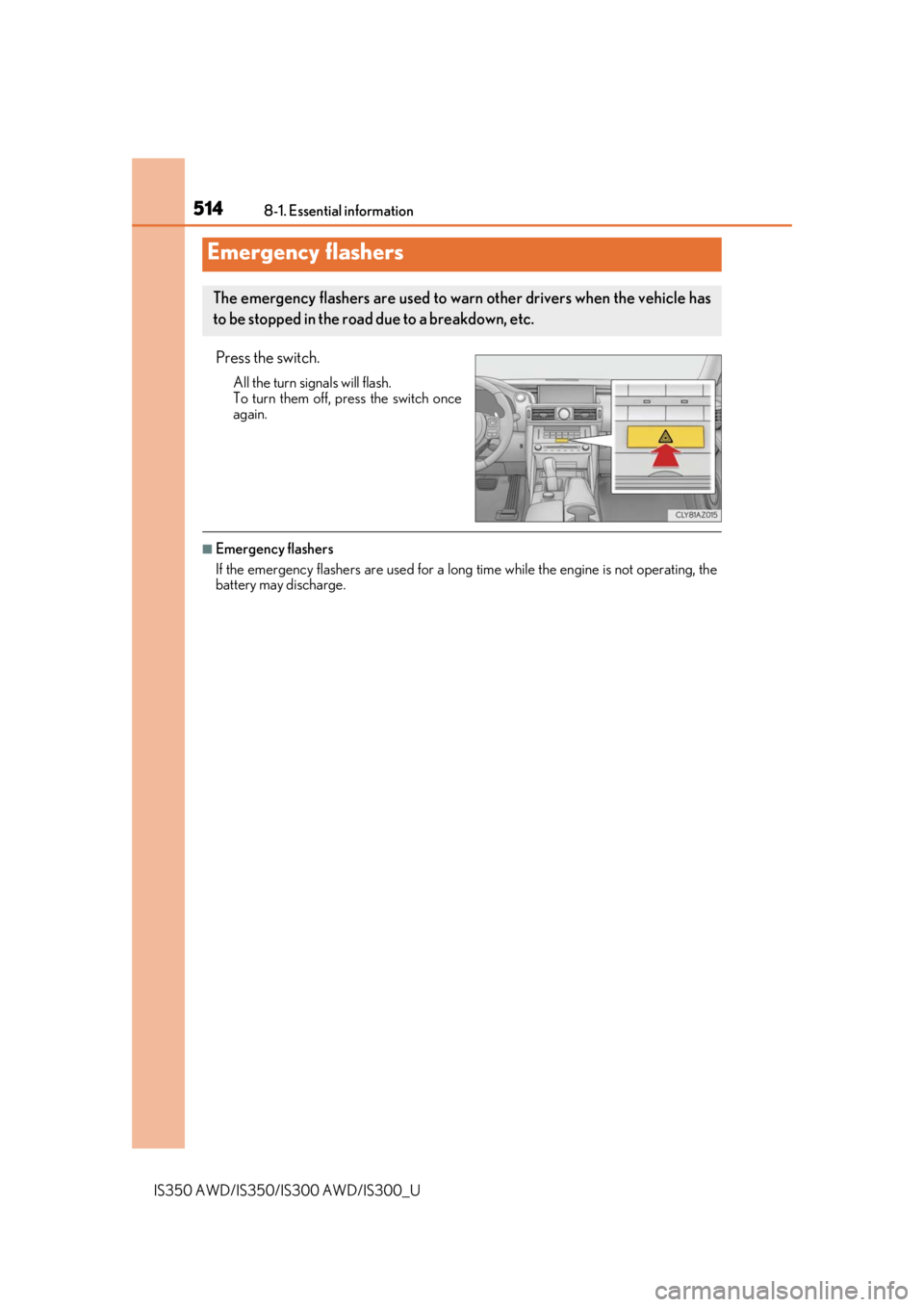
514
IS350 AWD/IS350/IS300 AWD/IS300_U8-1. Essential information
Press the switch.
All the turn signals will flash.
To turn them off, press the switch once
again.
■Emergency flashers
If the emergency flashers are used for a long time while the engine is not operating, the
battery may discharge.
Emergency flashers
The emergency flashers are used to warn other drivers when the vehicle has
to be stopped in the road due to a breakdown, etc.
Page 515 of 660
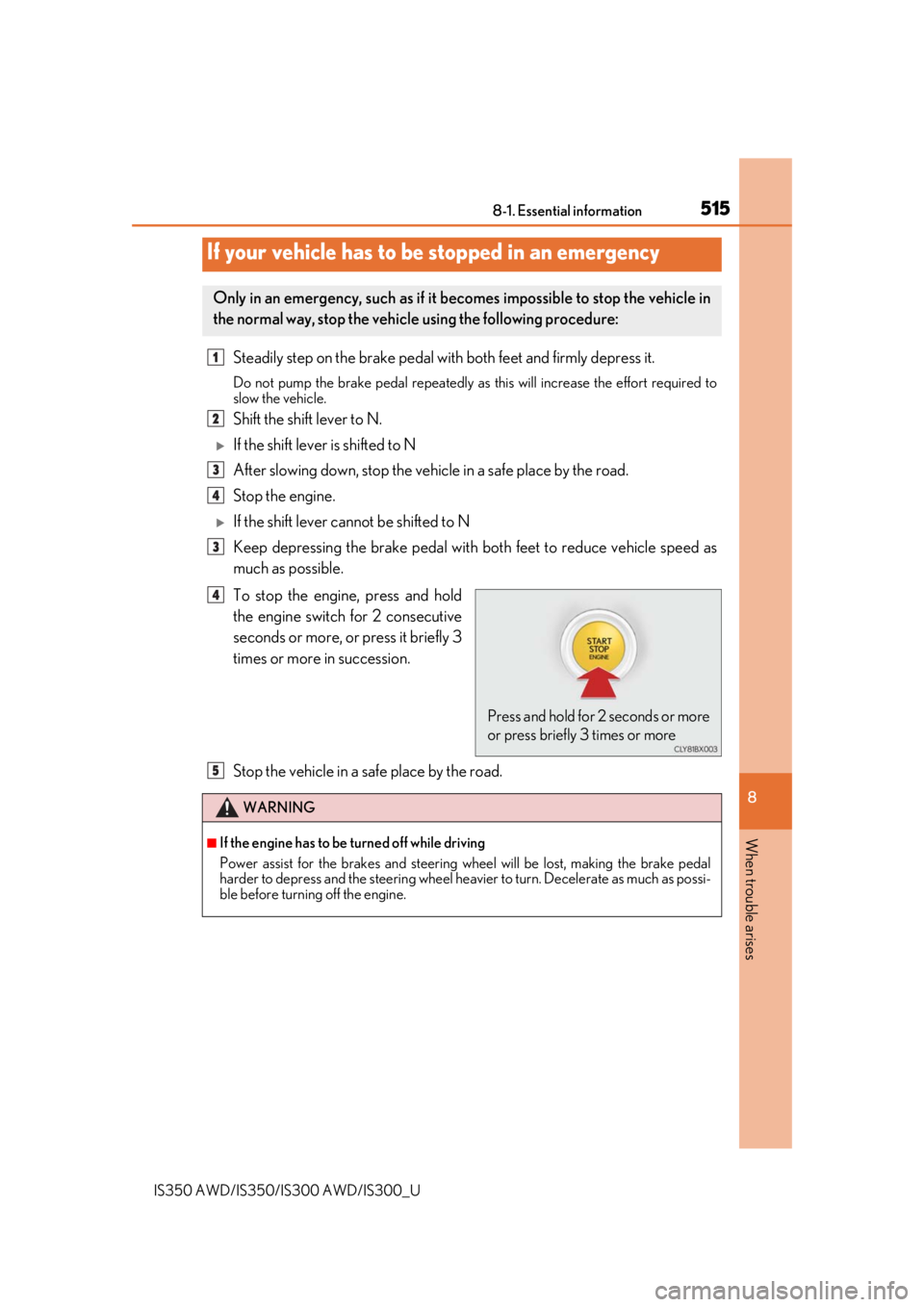
5158-1. Essential information
8
When trouble arises
IS350 AWD/IS350/IS300 AWD/IS300_U
Steadily step on the brake pedal with both feet and firmly depress it.
Do not pump the brake pedal repeatedly as this will increase the effort required to
slow the vehicle.
Shift the shift lever to N.
If the shift lever is shifted to N
After slowing down, stop the vehicle in a safe place by the road.
Stop the engine.
If the shift lever cannot be shifted to N
Keep depressing the brake pedal with both feet to reduce vehicle speed as
much as possible.
To stop the engine, press and hold
the engine switch for 2 consecutive
seconds or more, or press it briefly 3
times or more in succession.
Stop the vehicle in a safe place by the road.
If your vehicle has to be stopped in an emergency
Only in an emergency, such as if it becomes impossible to stop the vehicle in
the normal way, stop the vehicl e using the following procedure:
1
2
3
4
3
Press and hold for 2 seconds or more
or press briefly 3 times or more
4
WARNING
■If the engine has to be turned off while driving
Power assist for the brakes and steering wheel will be lost, making the brake pedal
harder to depress and the steering wheel heav ier to turn. Decelerate as much as possi-
ble before turning off the engine.
5
Page 516 of 660
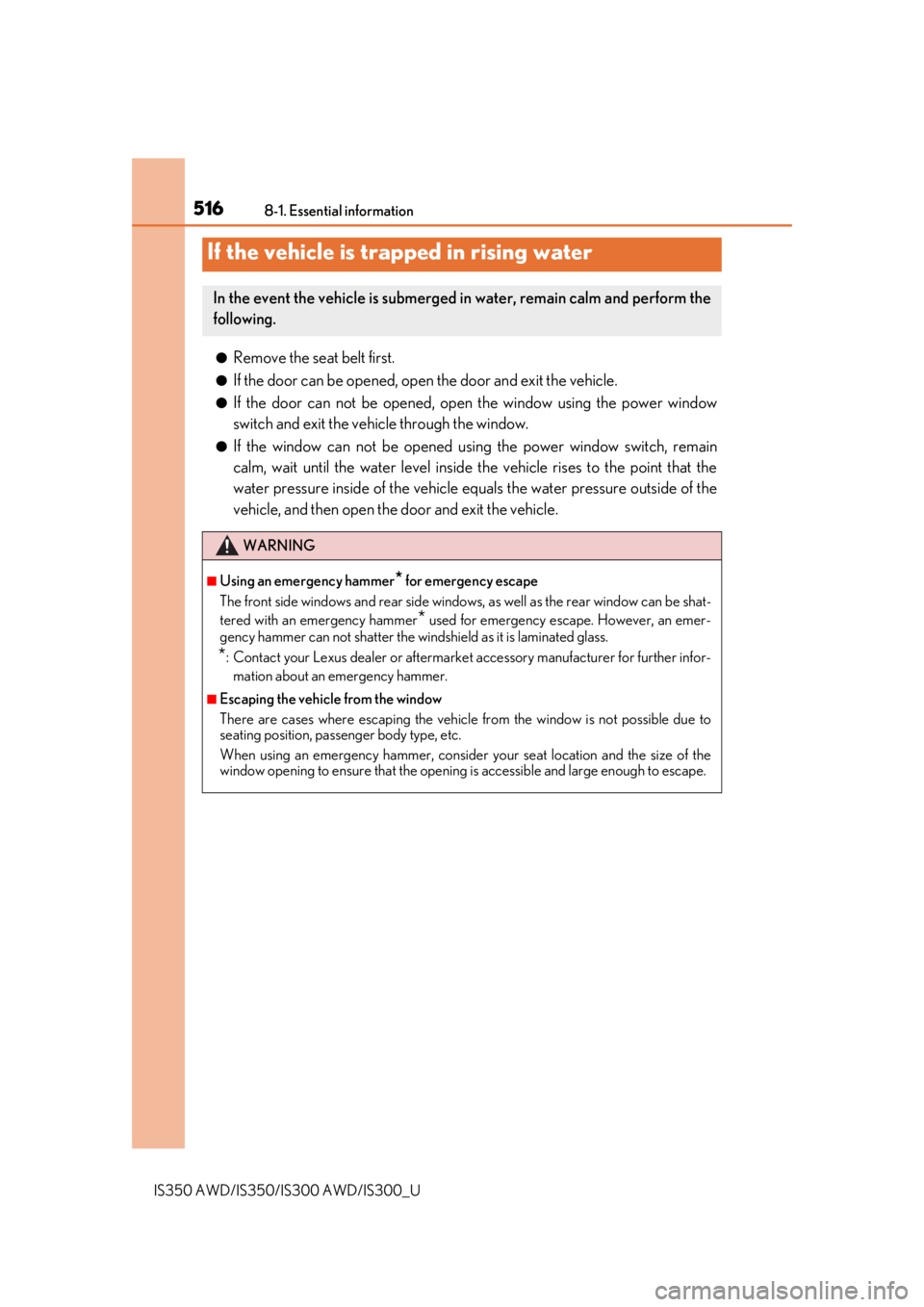
5168-1. Essential information
IS350 AWD/IS350/IS300 AWD/IS300_U
●Remove the seat belt first.
●If the door can be opened, open the door and exit the vehicle.
●If the door can not be opened, open the window using the power window
switch and exit the vehicle through the window.
●If the window can not be opened us ing the power window switch, remain
calm, wait until the water level inside the vehicle rises to the point that the
water pressure inside of the vehicle equals the water pressure outside of the
vehicle, and then open the door and exit the vehicle.
If the vehicle is trapped in rising water
In the event the vehicle is submerged in water, remain calm and perform the
following.
WARNING
■Using an emergency hammer* for emergency escape
The front side windows and rear side windows, as well as the rear window can be shat-
tered with an emergency hammer
* used for emergency escape. However, an emer-
gency hammer can not shatter the windshield as it is laminated glass.
*: Contact your Lexus dealer or aftermarke t accessory manufacturer for further infor-
mation about an emergency hammer.
■Escaping the vehicle from the window
There are cases where escaping the vehicl e from the window is not possible due to
seating position, passenger body type, etc.
When using an emergency hammer, consider your seat location and the size of the
window opening to ensure that the opening is accessible and large enough to escape.
Page 517 of 660
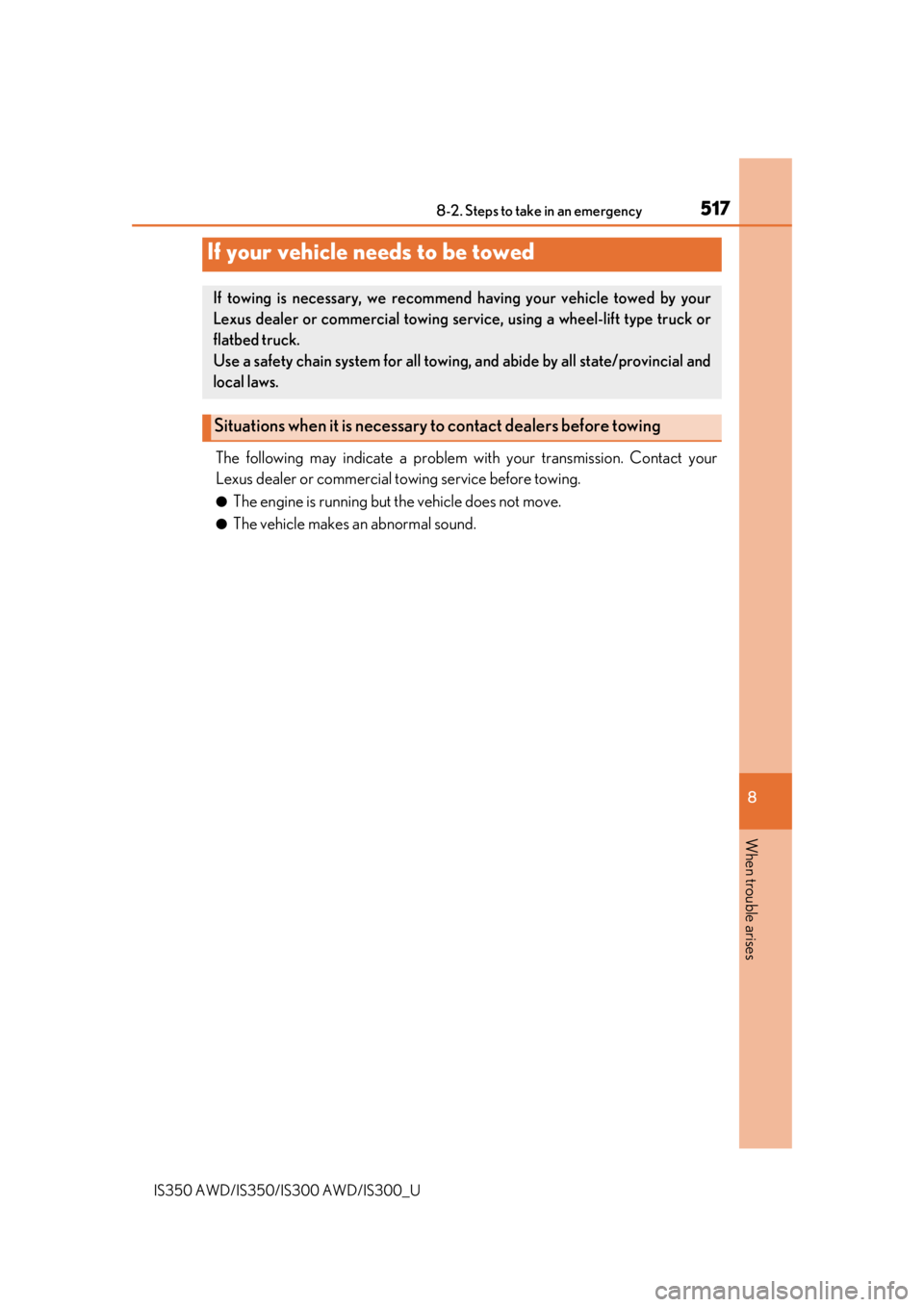
517
8
When trouble arises
IS350 AWD/IS350/IS300 AWD/IS300_U8-2. Steps to take in an emergency
The following may indicate a problem wi
th your transmission. Contact your
Lexus dealer or commercial to wing service before towing.
●The engine is running but the vehicle does not move.
●The vehicle makes an abnormal sound.
If your vehicle needs to be towed
If towing is necessary, we recommend having your vehicle towed by your
Lexus dealer or commercial towing se rvice, using a wheel-lift type truck or
flatbed truck.
Use a safety chain system for all towing, and abide by all state/provincial and
local laws.
Situations when it is necessary to contact dealers before towing
Page 518 of 660
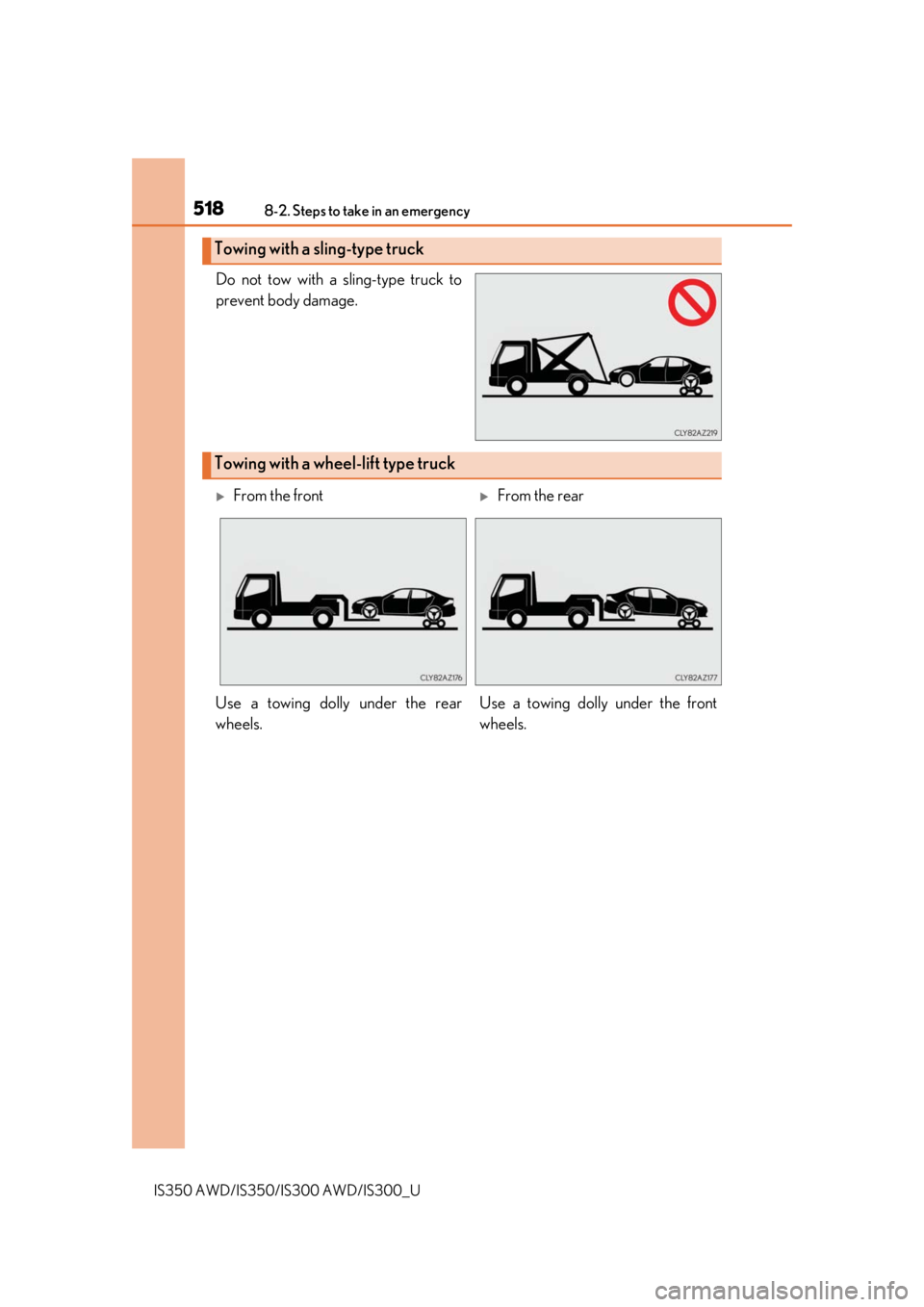
5188-2. Steps to take in an emergency
IS350 AWD/IS350/IS300 AWD/IS300_U
Do not tow with a sling-type truck to
prevent body damage.
Towing with a sling-type truck
Towing with a wheel-lift type truck
From the frontFrom the rear
Use a towing dolly under the rear
wheels. Use a towing dolly under the front
wheels.
Page 519 of 660
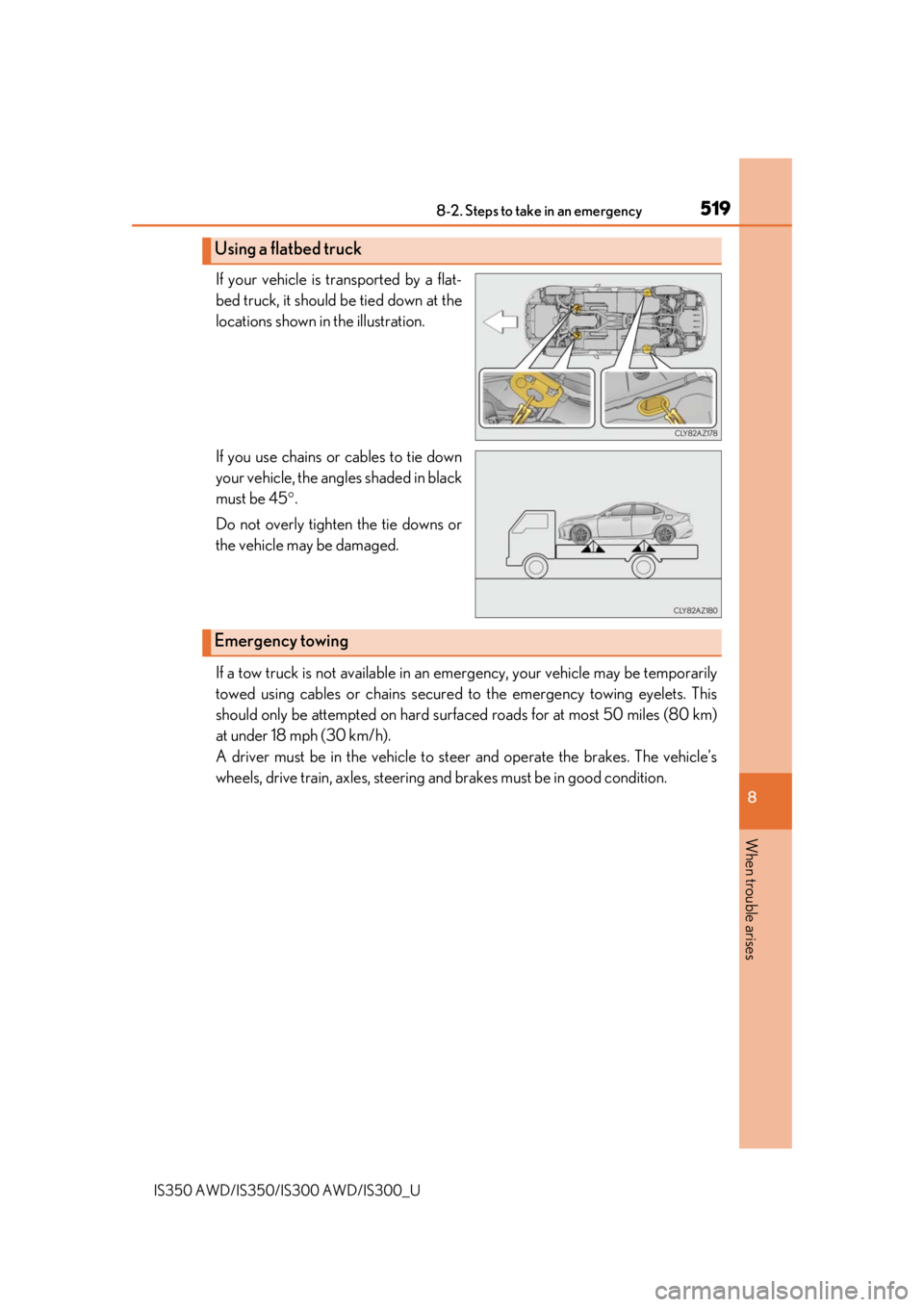
5198-2. Steps to take in an emergency
8
When trouble arises
IS350 AWD/IS350/IS300 AWD/IS300_U
If your vehicle is transported by a flat-
bed truck, it should be tied down at the
locations shown in the illustration.
If you use chains or cables to tie down
your vehicle, the angles shaded in black
must be 45.
Do not overly tighten the tie downs or
the vehicle may be damaged.
If a tow truck is not available in an em ergency, your vehicle may be temporarily
towed using cables or chains secured to the emergency towing eyelets. This
should only be attempted on hard surf aced roads for at most 50 miles (80 km)
at under 18 mph (30 km/h).
A driver must be in the vehicle to st eer and operate the brakes. The vehicle’s
wheels, drive train, axles, steering an d brakes must be in good condition.
Using a flatbed truck
Emergency towing
Page 520 of 660
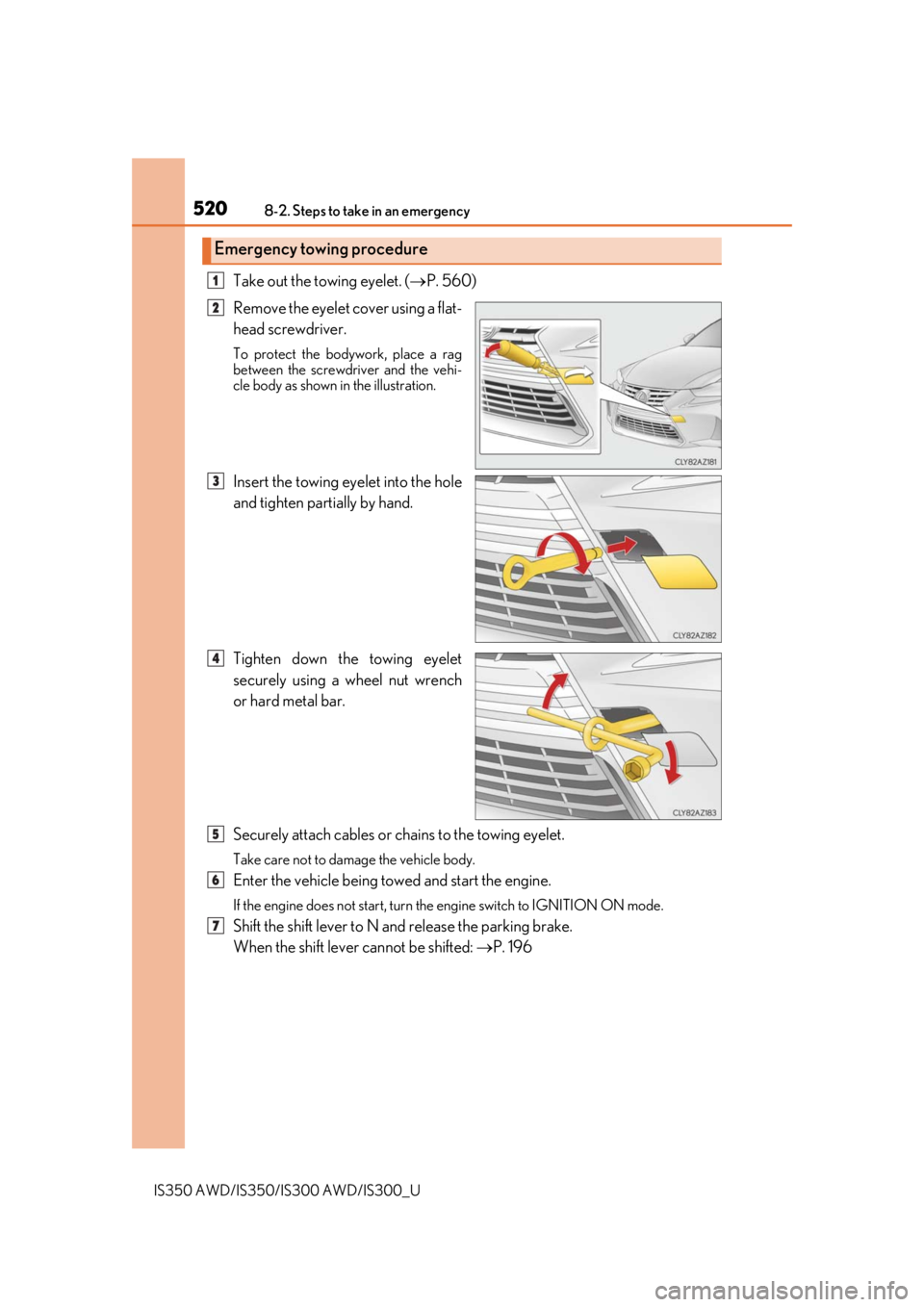
5208-2. Steps to take in an emergency
IS350 AWD/IS350/IS300 AWD/IS300_U
Take out the towing eyelet. (P. 560)
Remove the eyelet cover using a flat-
head screwdriver.
To protect the bodywork, place a rag
between the screwdriver and the vehi-
cle body as shown in the illustration.
Insert the towing eyelet into the hole
and tighten partially by hand.
Tighten down the towing eyelet
securely using a wheel nut wrench
or hard metal bar.
Securely attach cables or chains to the towing eyelet.
Take care not to damage the vehicle body.
Enter the vehicle being towed and start the engine.
If the engine does not start, turn the engine switch to IGNITION ON mode.
Shift the shift lever to N and release the parking brake.
When the shift lever cannot be shifted: P. 196
Emergency towing procedure
1
2
3
4
5
6
7